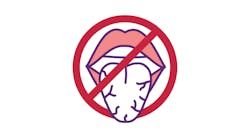Dry mouth continues to be a complaint we hear from patients. It is estimated that about 22% or one in four patients suffer from xerostomia.1 Dry mouth affects patients of all ages, and is caused by various factors: it could be age related, medication induced, a side effect from an autoimmune disorder such as Sjögren’s, or it could be related to a breathing disorder.
More than discomfort
Regardless of the cause, we, as dental professionals, understand that dry mouth significantly increases a patient’s risk for dental disease. CAMBRA—caries management by risk assessment—factors in salivary flow when assessing a patient’s risk for caries.2 Inadequate salivary flow makes a patient high risk. But do our patients realize their dry mouth is more than a nuisance or a discomfort? Do they realize that it puts them at increased risk for dental disease? The answer is likely no, they do not. Most patients don’t associate their dry mouth with recurrent decay. They do not realize that by using quality dry-mouth products they are not only increasing their oral comfort but lowering their risk for disease.
Related reading:
- Xerostomia, your patient’s worst nightmare
- Xerostomia through a pandemic: Considerations for clinicians, patients, and the general population
- Dry mouth relief: 9 products for treating xerostomia
Firsthand experience
How many times do we recommend dry-mouth products to patients only to have them come back, often frustrated, saying it didn’t work? I used to hear this frequently, and honestly didn’t think too much about it. Then I became a dry-mouth patient after my Sjögren’s diagnosis in 2016. I had to learn what worked and what that meant to me as a patient. It is so important that we set appropriate expectations when we recommend dry-mouth products. Relieving dry-mouth symptoms and lowering risk takes more than one product used once a day. It takes a multitude of products and different forms, used throughout the day. We want to keep our goals in mind when we talk about products to our patients. Of course we want them to experience comfort and to hydrate and lubricate their soft tissue, but we also want to lower their risk for disease with safe products.
It's all about personalization
Each dry-mouth patient is unique, which makes tailoring our product recommendations crucial. For example, an older patient who has difficulty chewing and swallowing may find a gel to be the best delivery method. Younger patients may prefer a spray and gum throughout the day. We want to keep these factors in mind and discuss how to use the products we recommend and what to expect. Simply telling patients to look for a product in the store or on Amazon isn’t enough. If we told a patient to purchase a dry-mouth spray but didn’t tell them to use it several times throughout the day and night, they may use the product once and tell us it didn’t work for them, when, in actuality, they perhaps did not use the product appropriately for their needs.
Things to look for
There are hundreds of dry-mouth products on the market—it’s nearly impossible to know everything out there and how to instruct our patients on each one. When we look at dry-mouth products, there are a few important factors. First, and arguably the most important, is the pH of the product. Most dry-mouth patients suffer from low pH and poor buffering capacity of their saliva against acidic attacks. If we recommend a product with a low pH to a dry-mouth patient, that could be harmful. Looking for a neutral pH is critical; you can contact companies directly for this information. We also want consider the ingredient list. Ideally, we want to see a high xylitol content in dry-mouth products. It’s a safe, quality ingredient that signals the brain to produce more saliva.3 We also want to look at price and ease of use, and then look for delivery options. You may want to consider recommending sprays, gels, lozenges, and gum options, and in many cases, patients may use each of these delivery methods for relief. I know I certainly do as a dry-mouth patient.
Takeaways
I hope this has provided a different way to look at taking product recommendations a step further in the operatory by telling patients what to expect and with what frequency they can use the products we recommend. By setting appropriate expectations, we ensure that our patients know how to appropriately use products we recommend and what to expect, which will lead to less frustration and set them up for success. Also, by taking the time to have a deeper discussion on product expectations, you will help your patients find quality products that help them find relief and lower their risk. Believe me, your dry-mouth patients will be so grateful.
Editor's note: This article appeared in the January/February 2023 print edition of RDH magazine. Dental hygienists in North America are eligible for a complimentary print subscription. Sign up here.
References
- Agostini BA, Cericato GO, Silveira ERD, Nascimento GG, Costa FDS, Thomson WM, Demarco FF. How common is dry mouth? Systematic review and meta-regression analysis of prevalence estimates. Braz Dent J. 2018;29(6):606-618. doi:10.1590/0103-6440201802302
- CAMBRA. University of California San Francisco School of Dentistry. 2022. https://dentistry.ucsf.edu/research/cambra
- Park E, Na HS, Jeong S, Chung J. Xylitol stimulates saliva secretion via muscarinic receptor signaling pathway. Int J Oral Biol. 2019;44(2):62-70. doi:10.11620/ijob.2019.44.2.62






